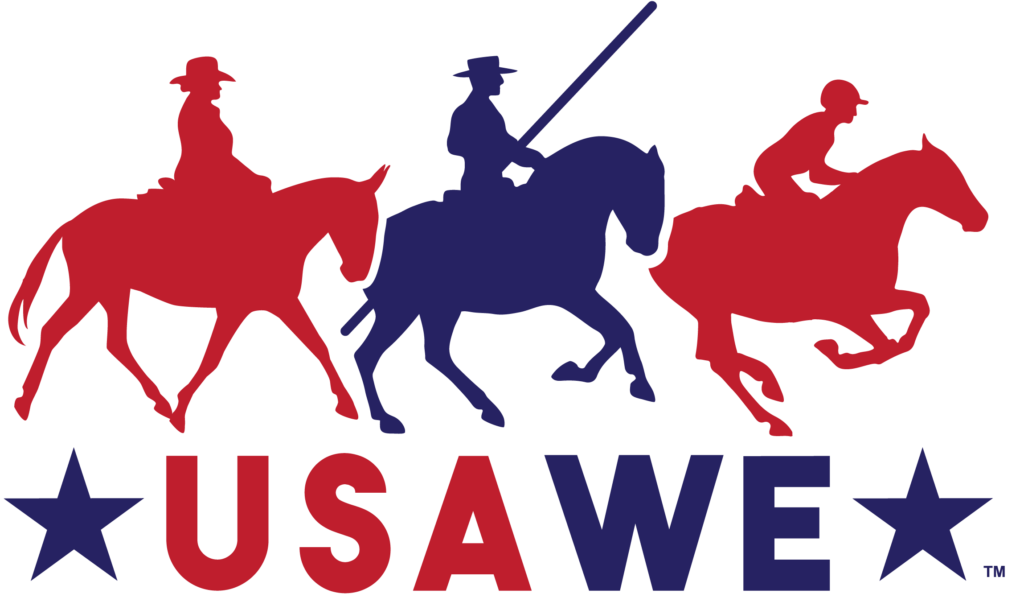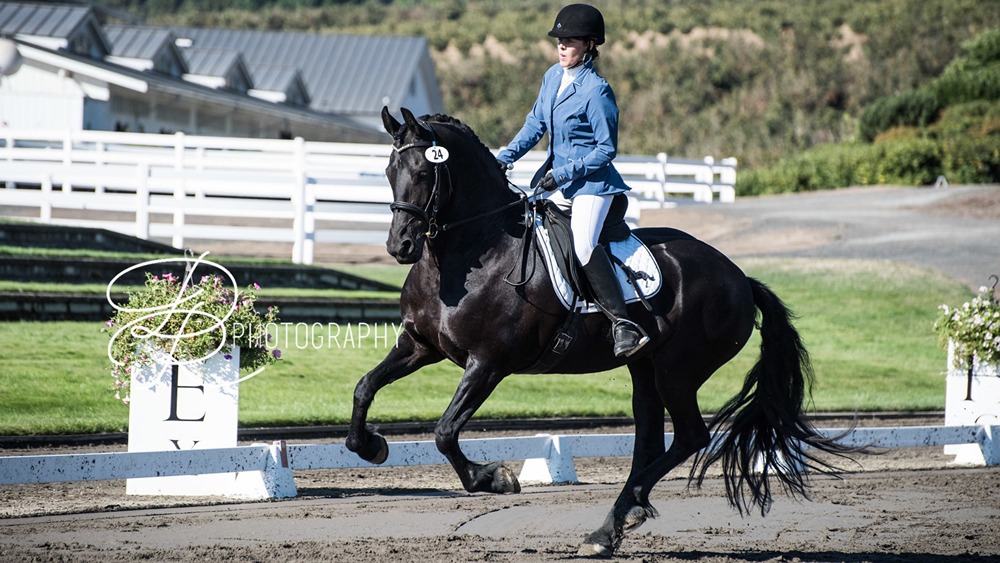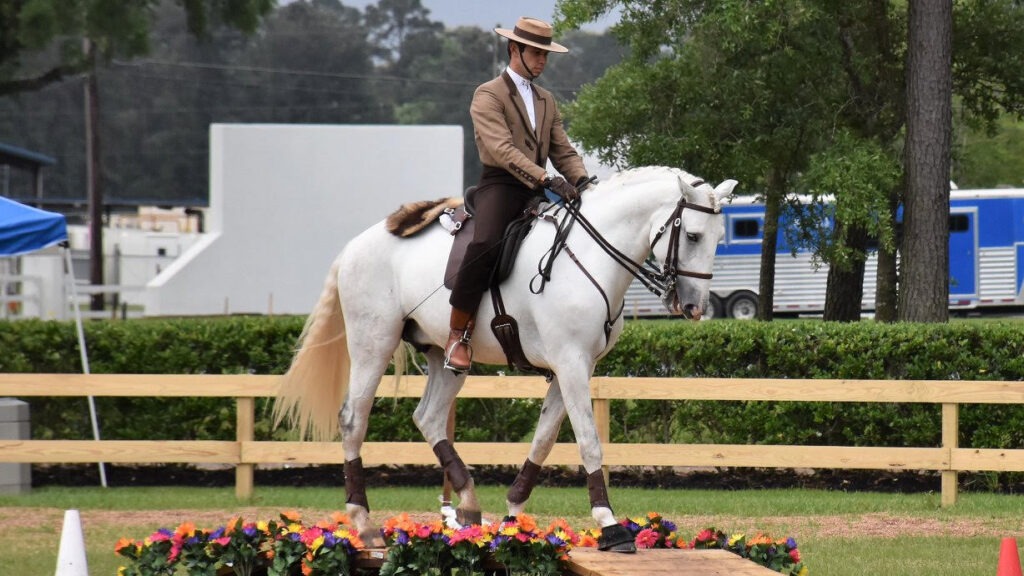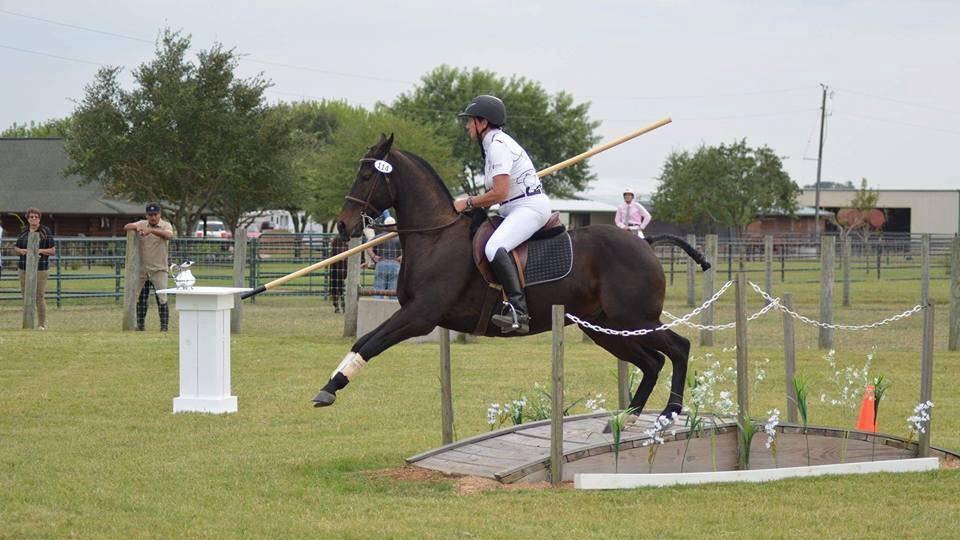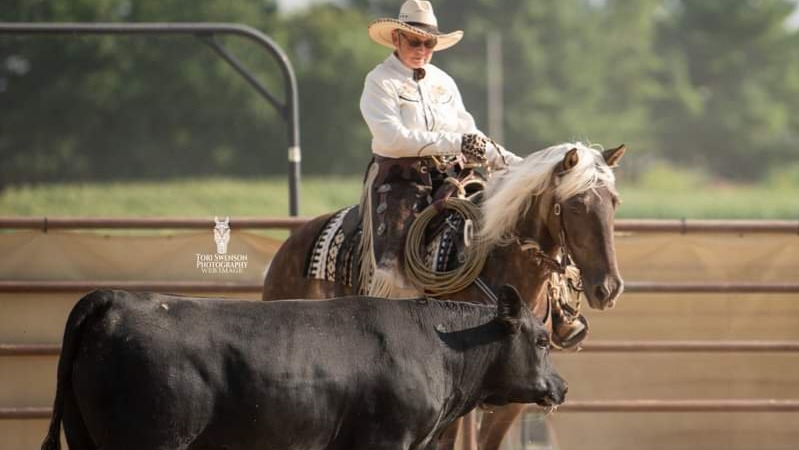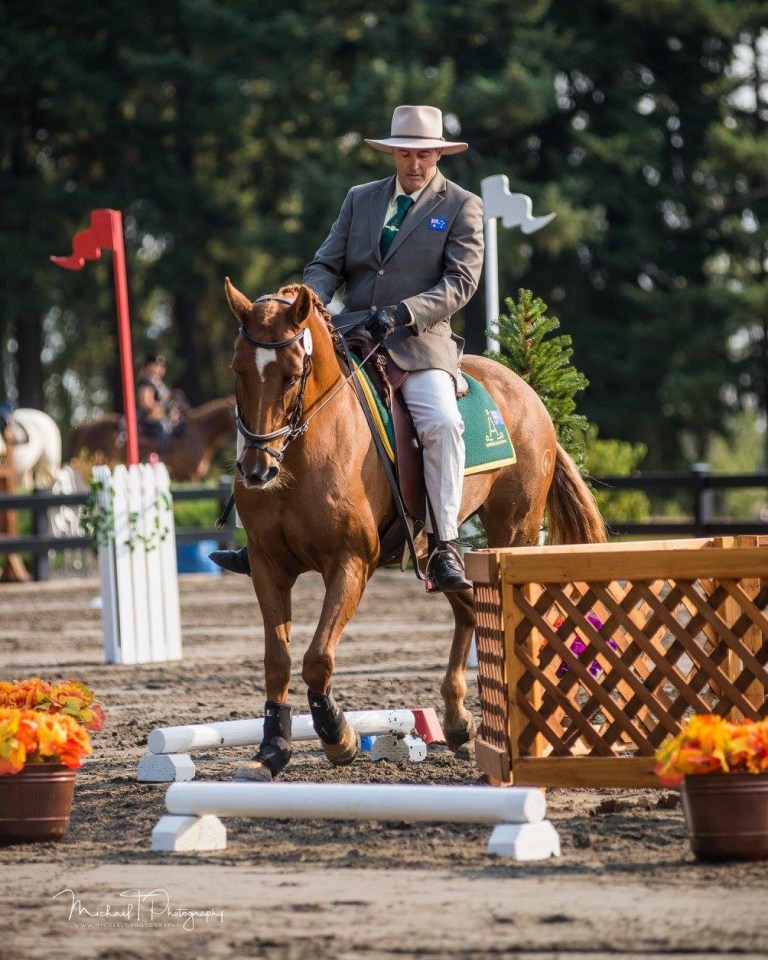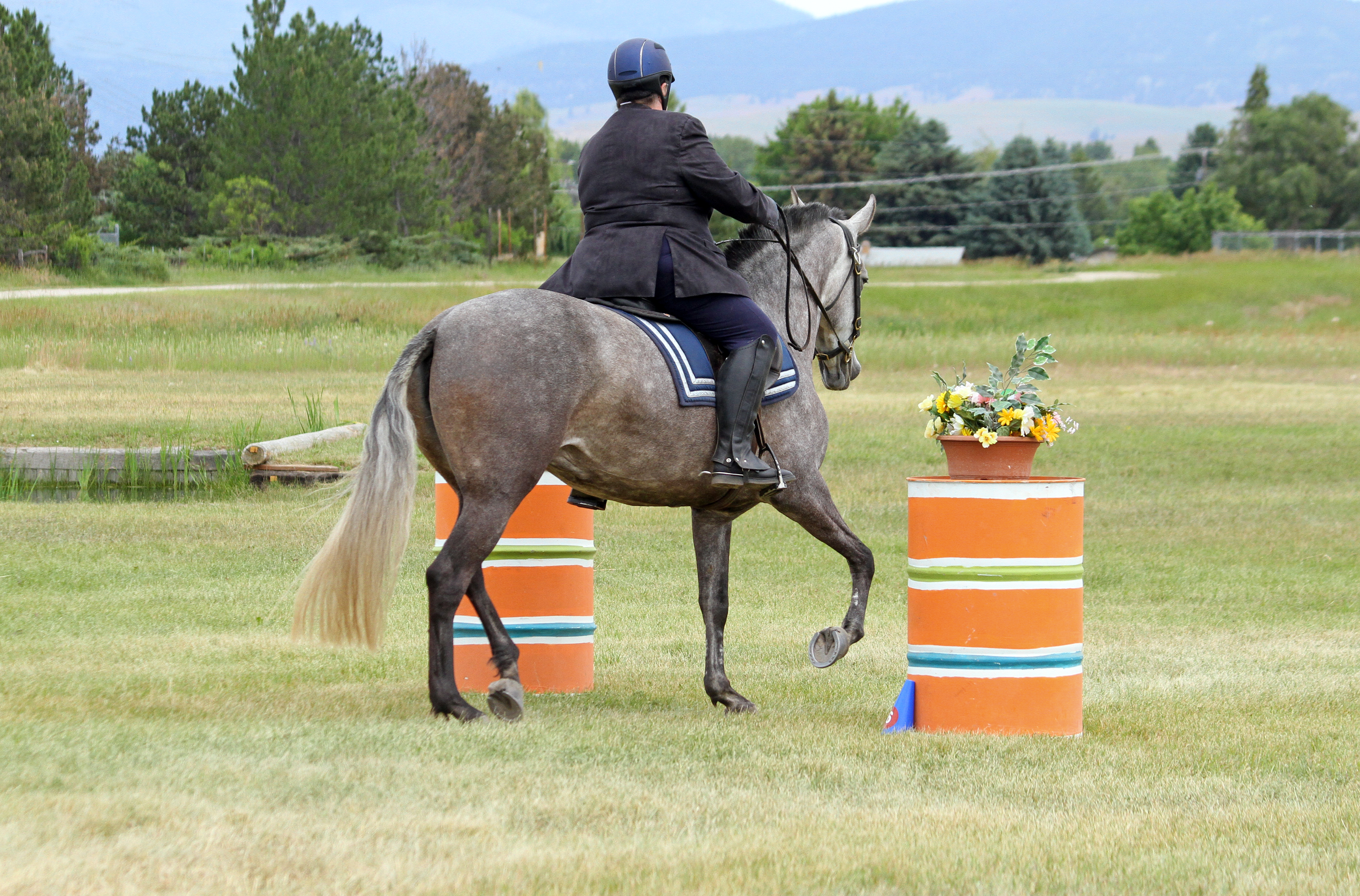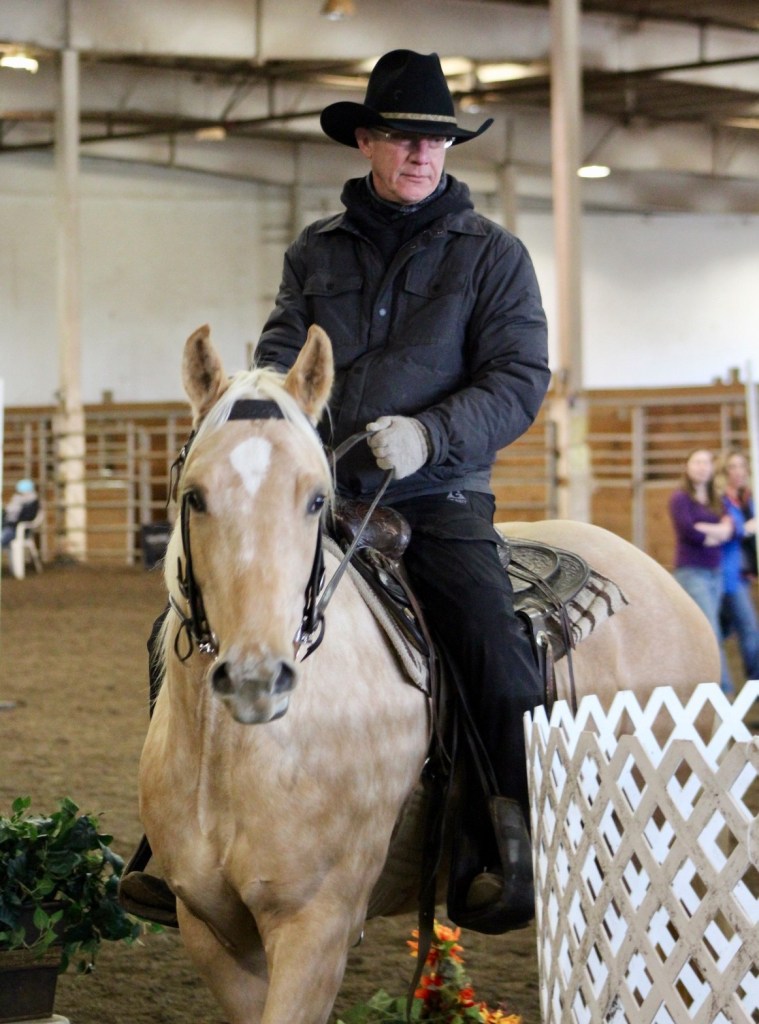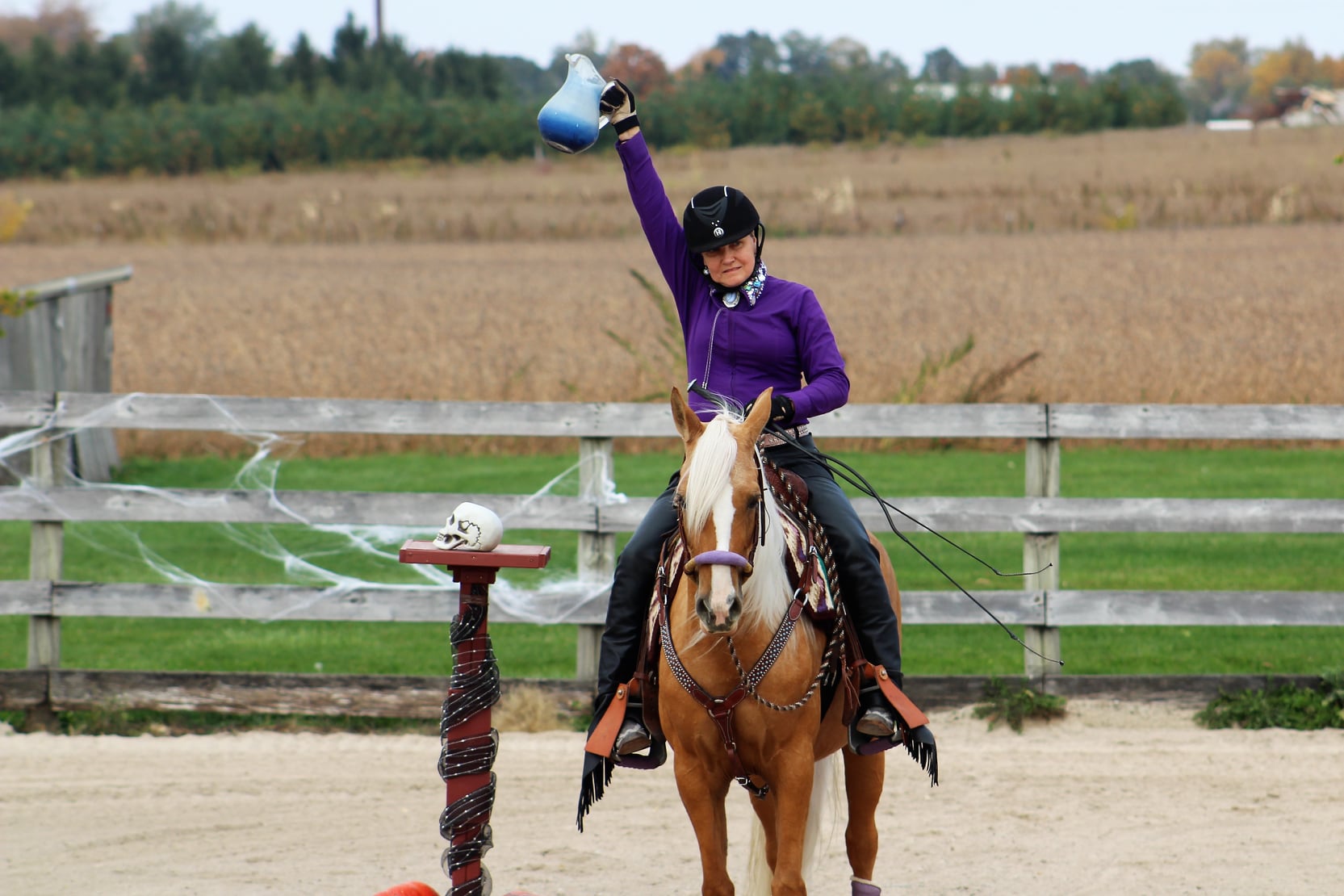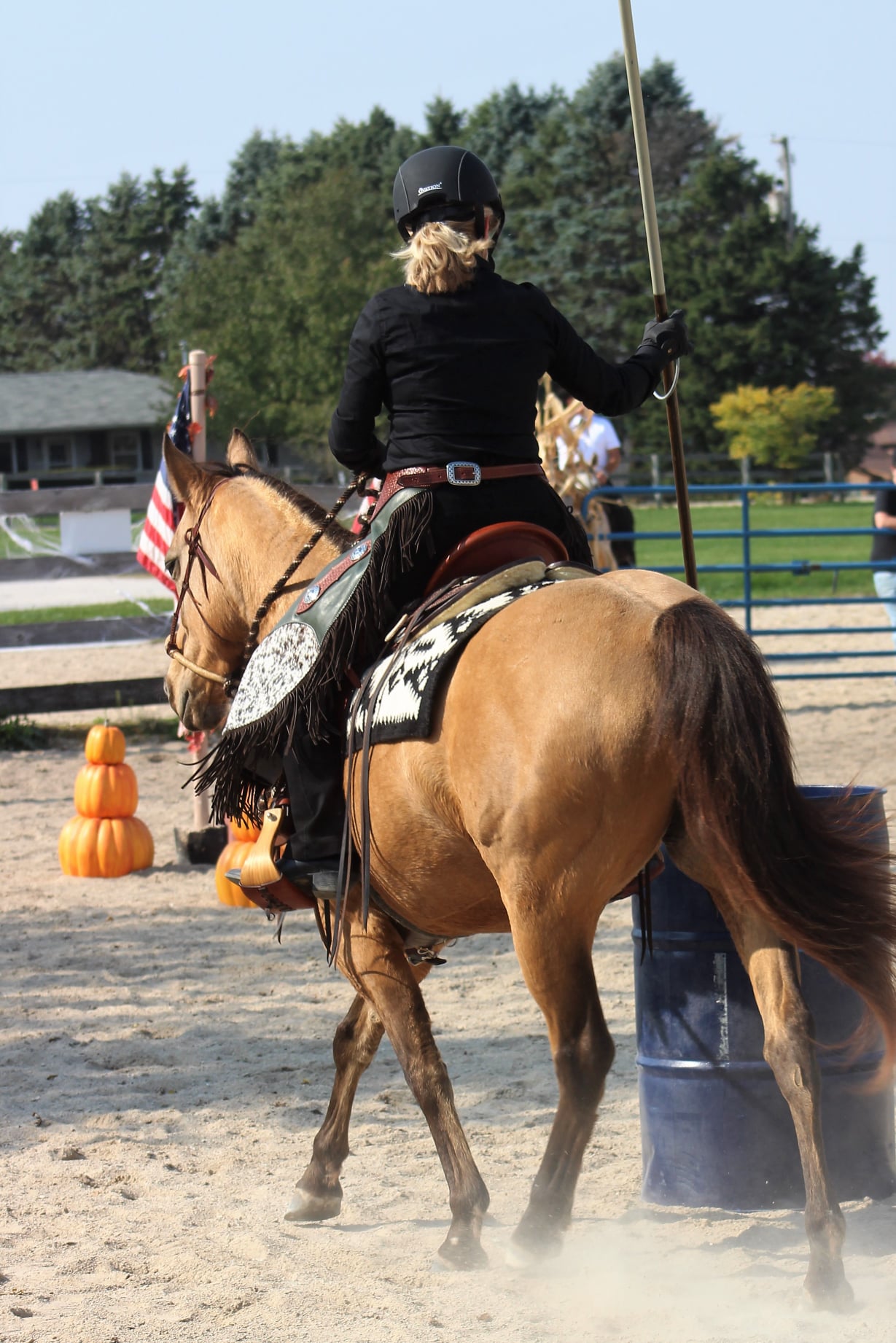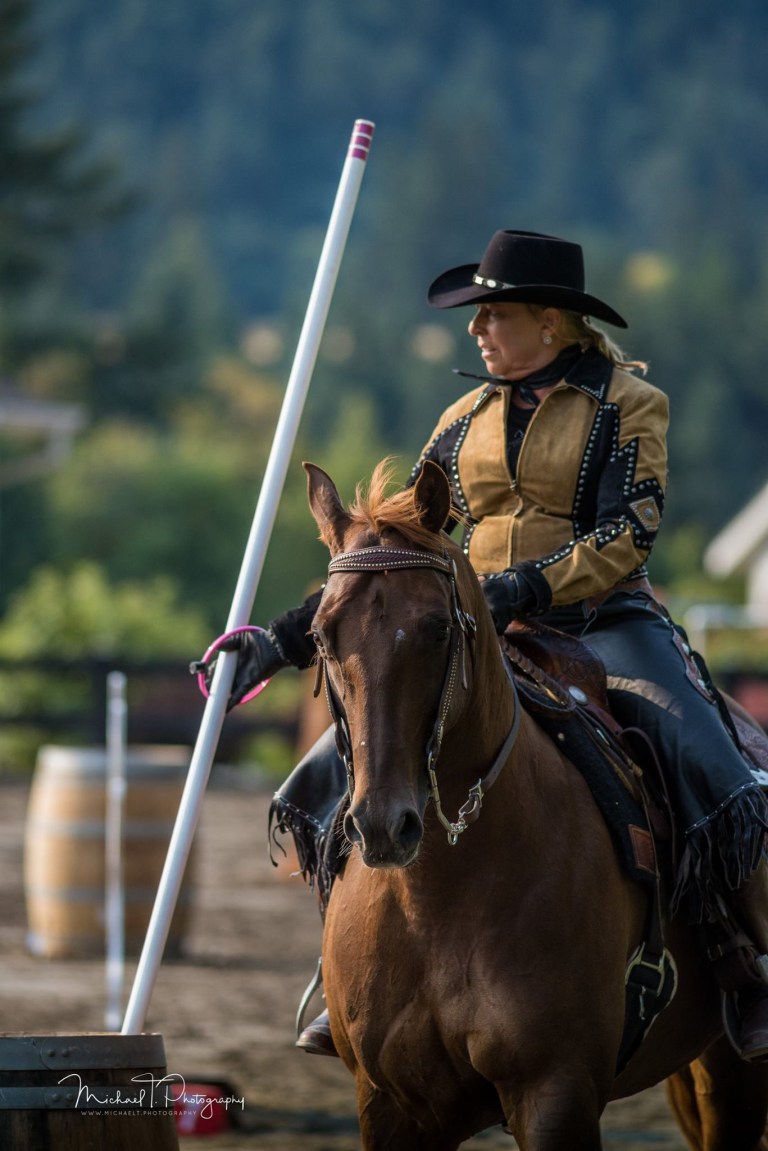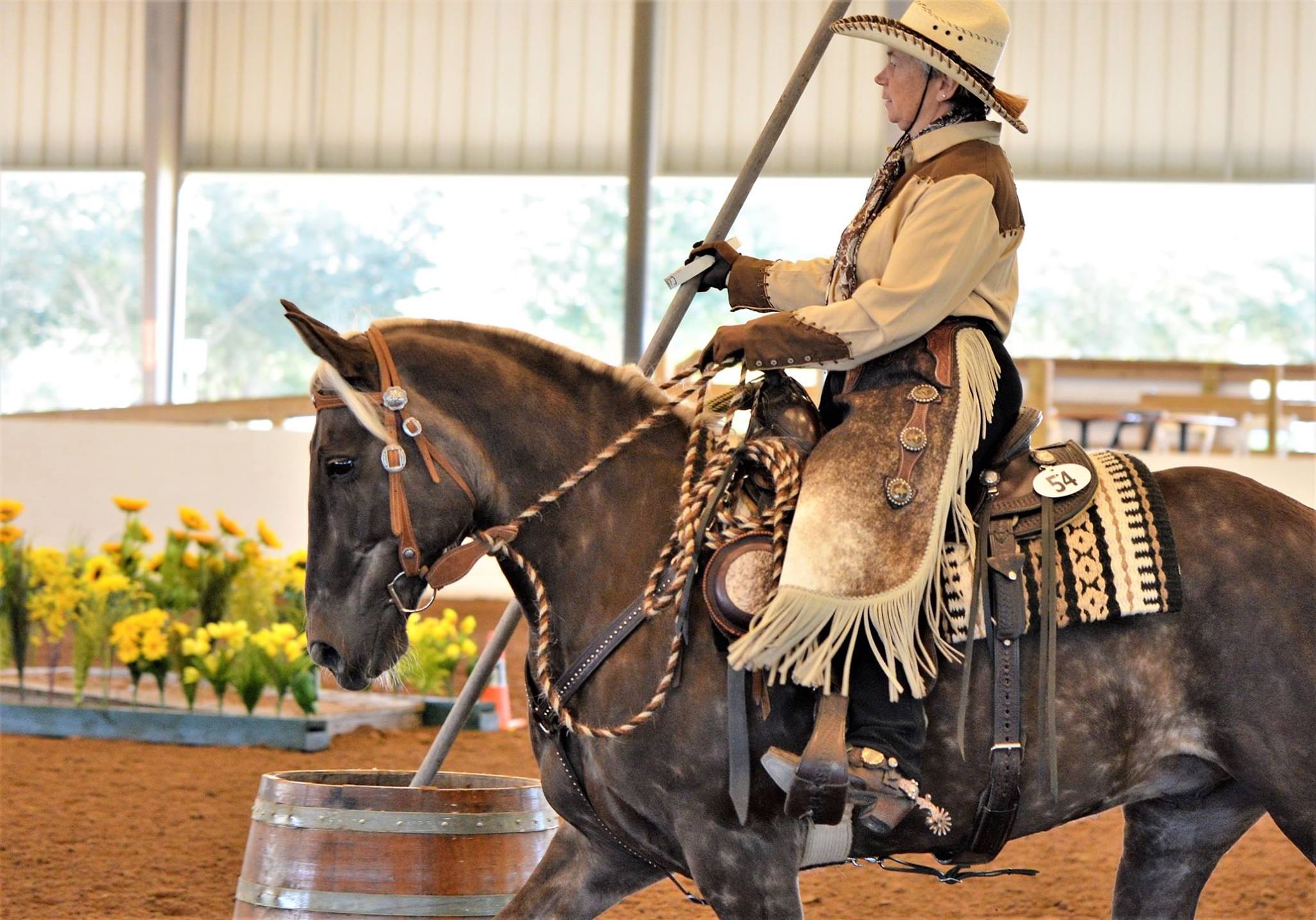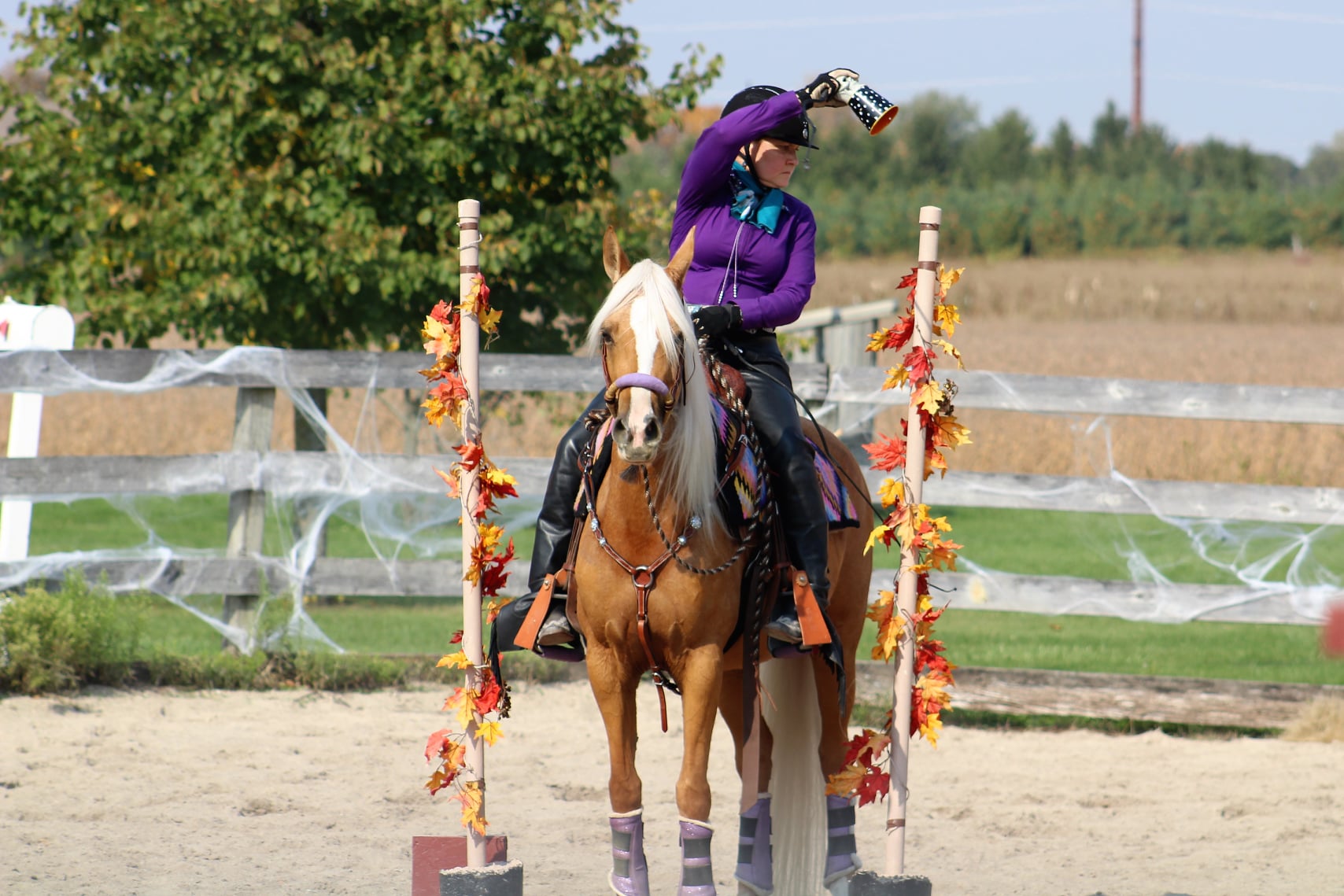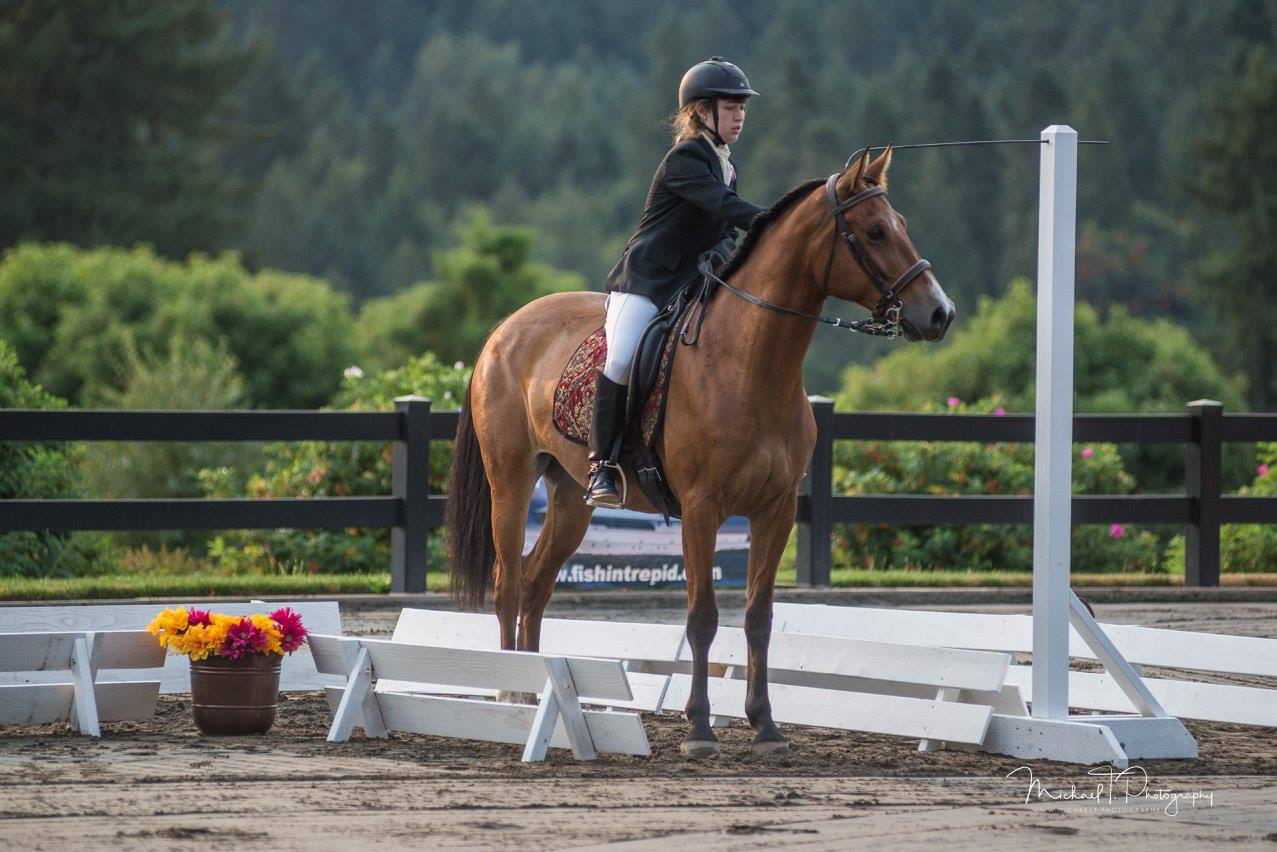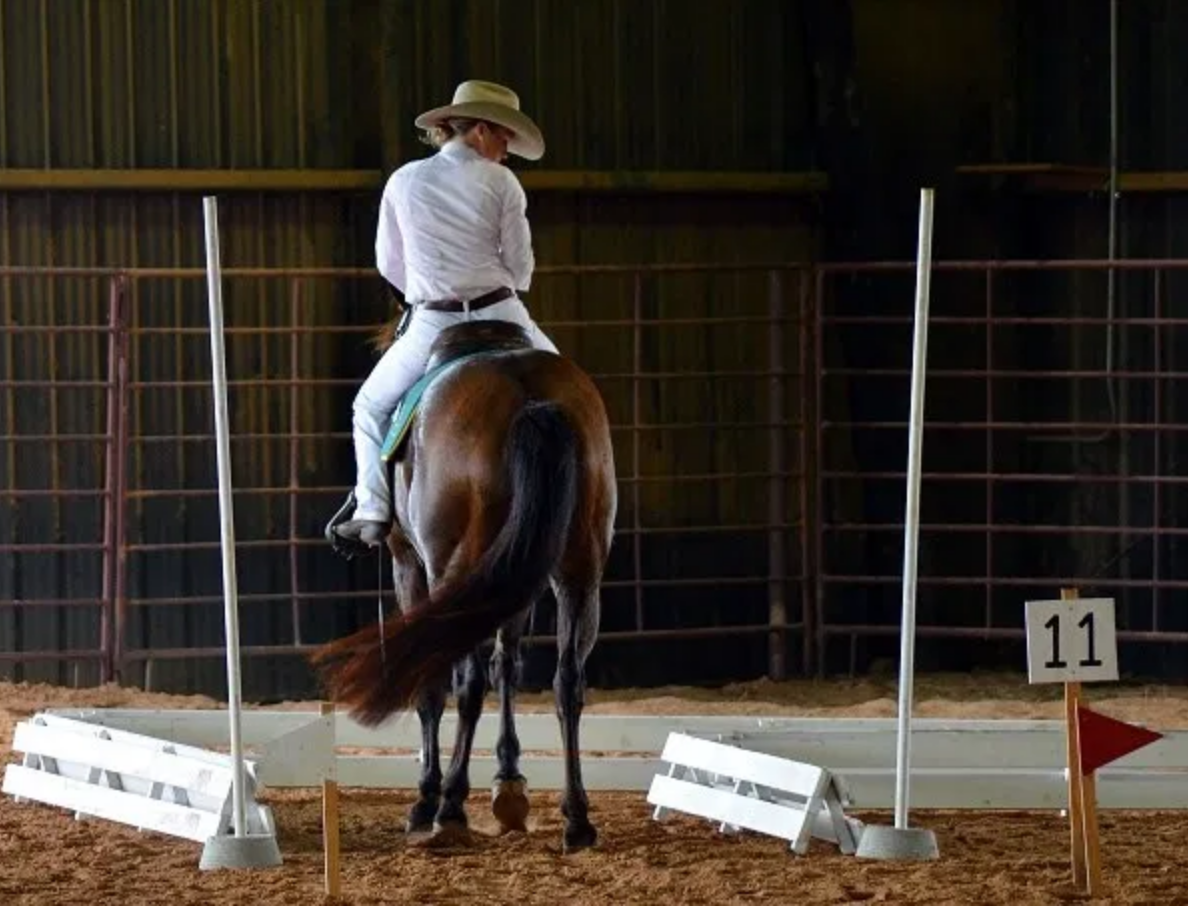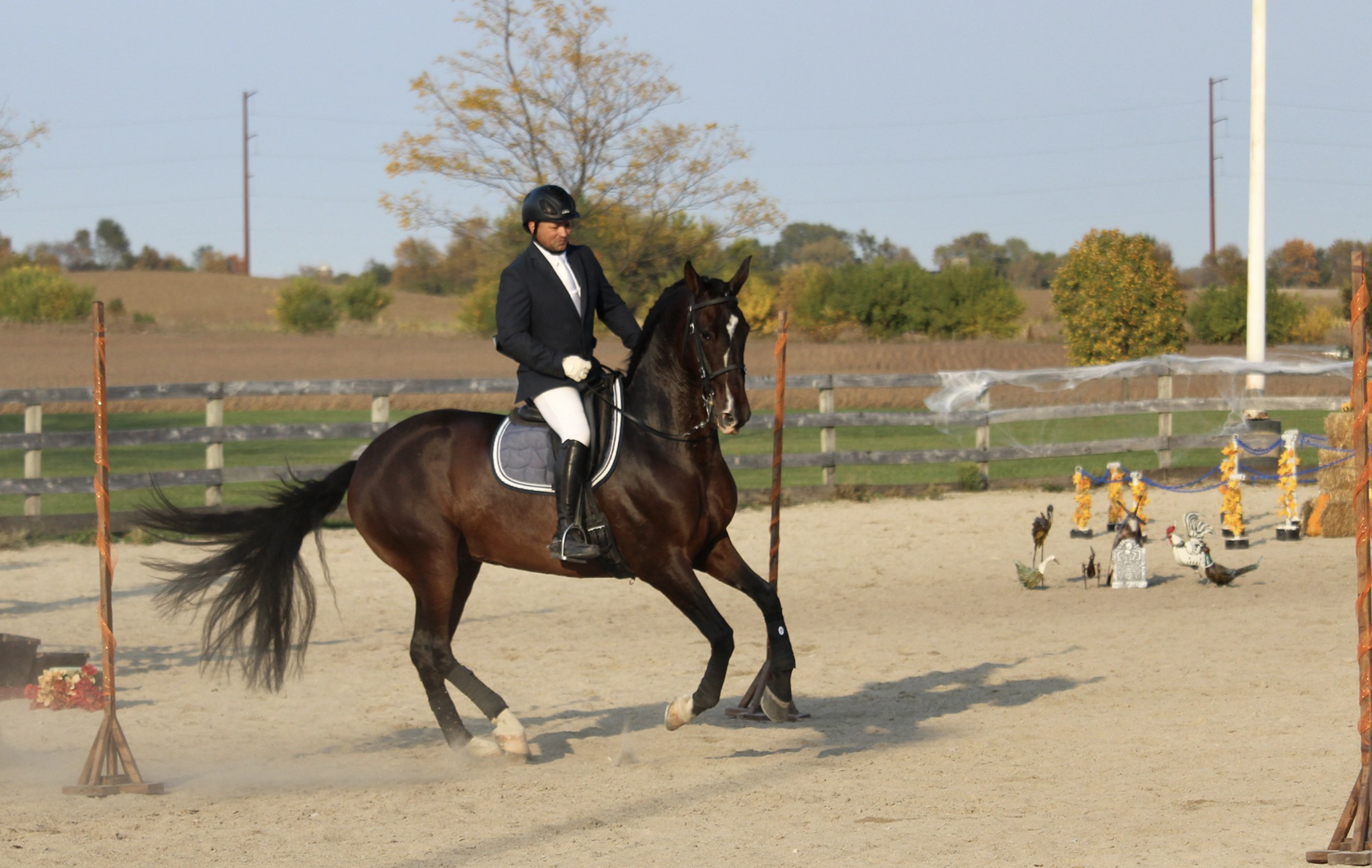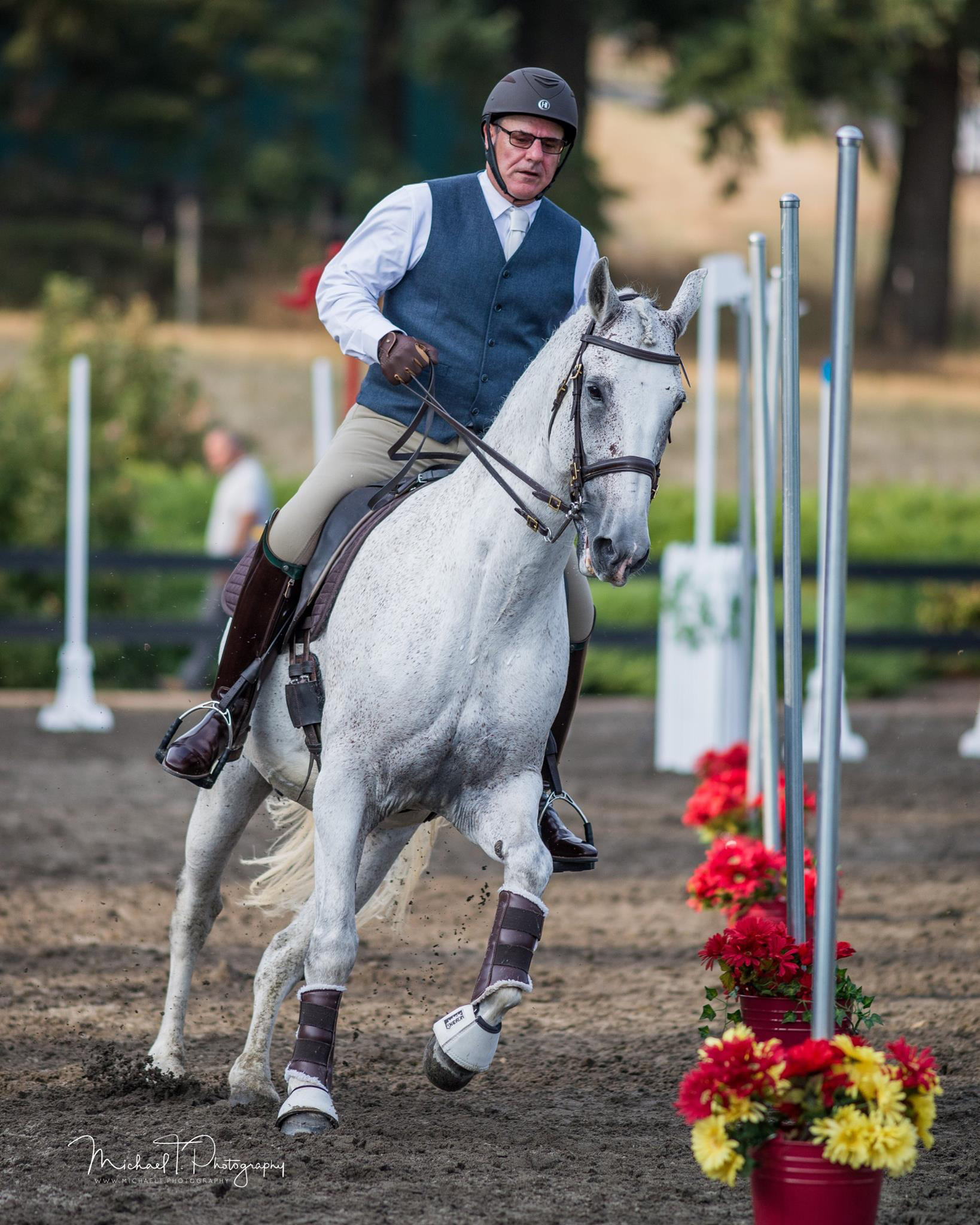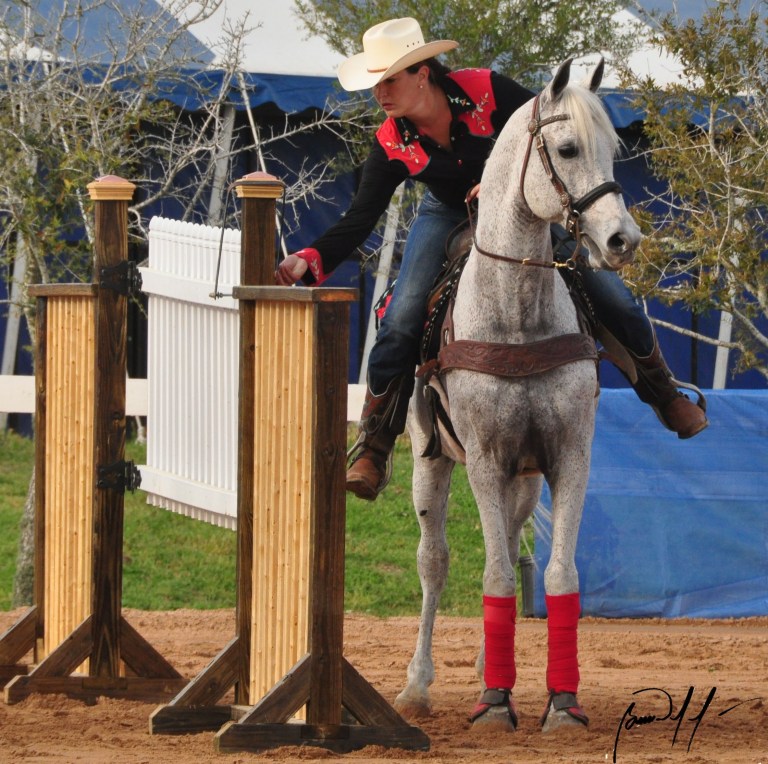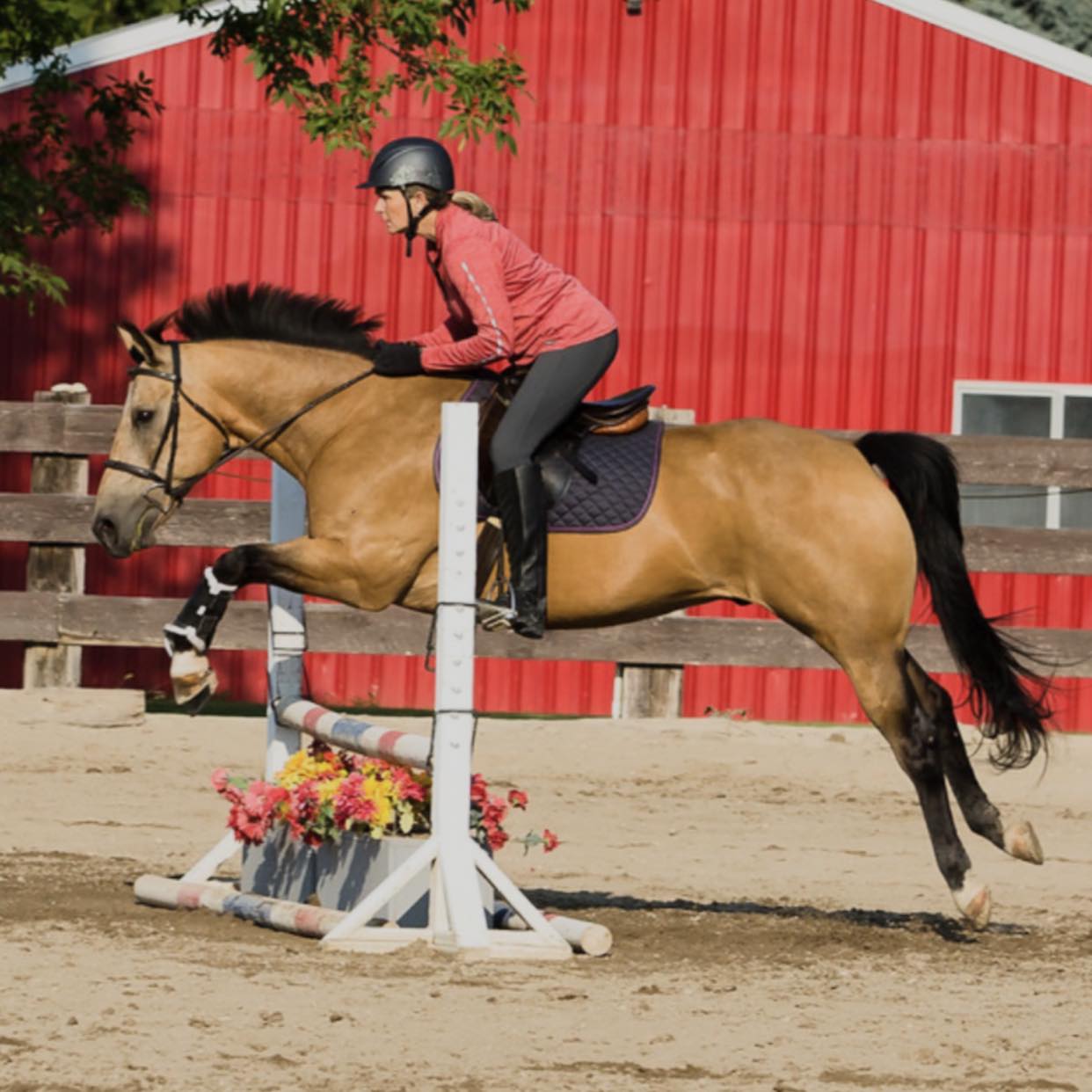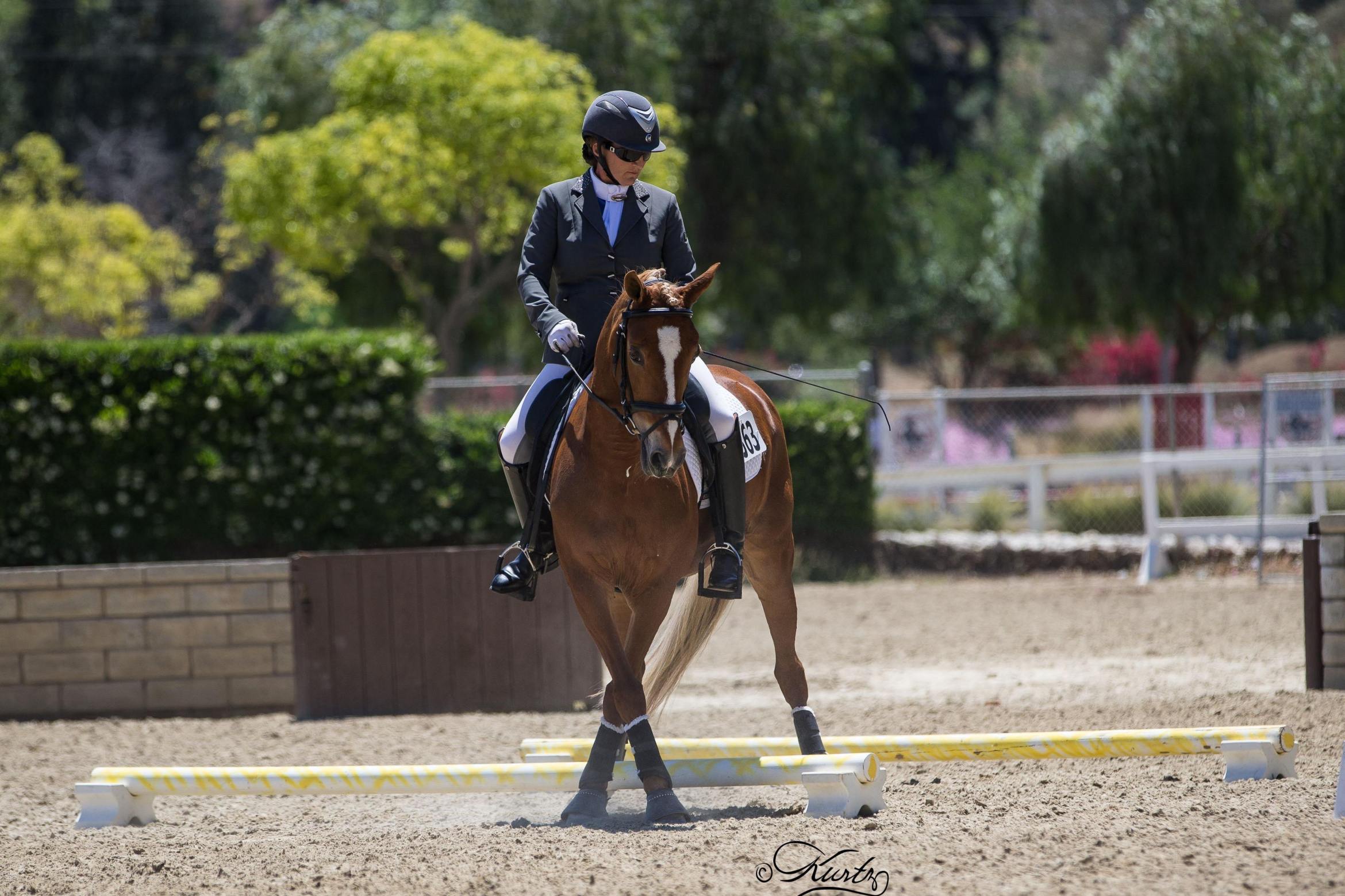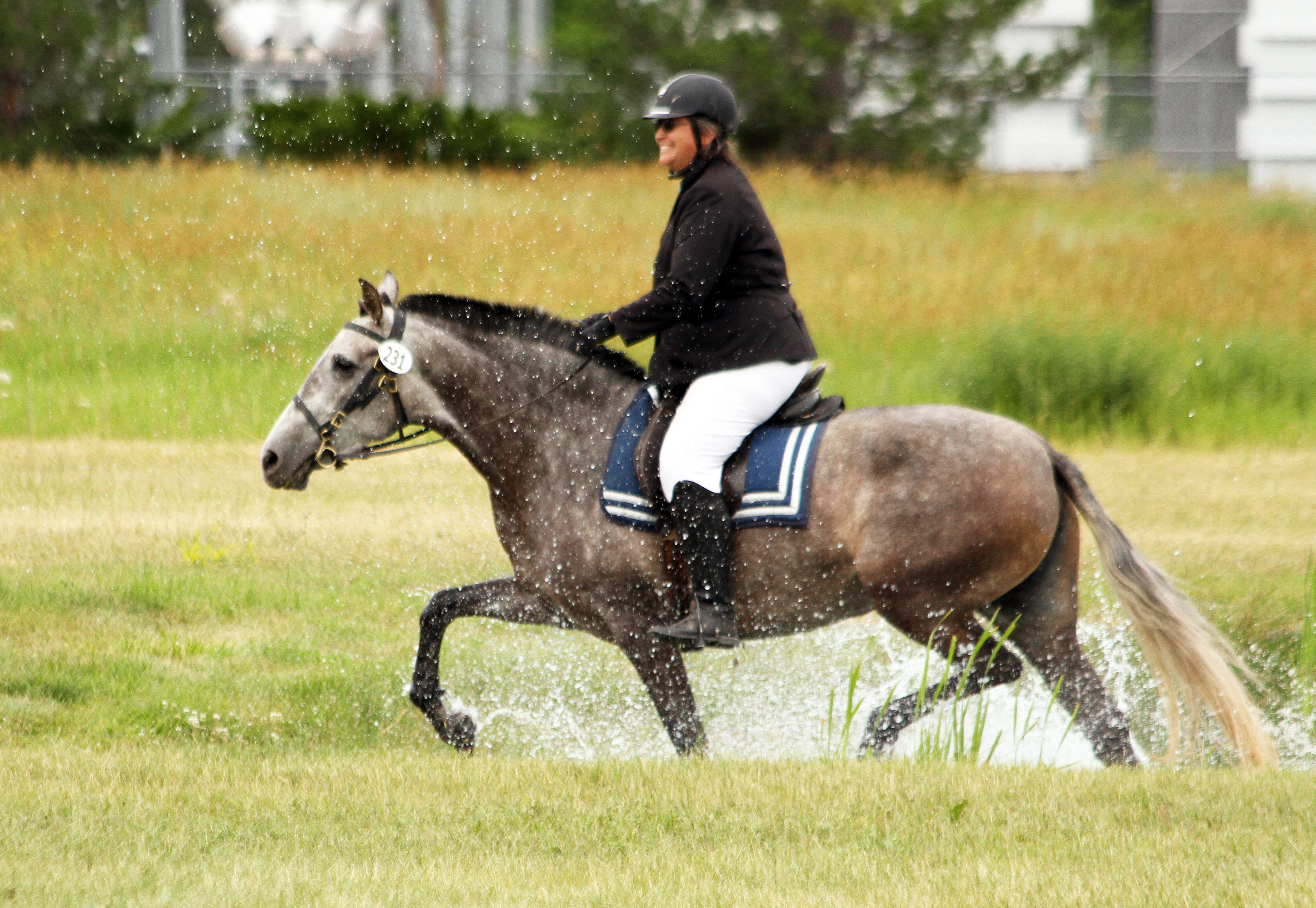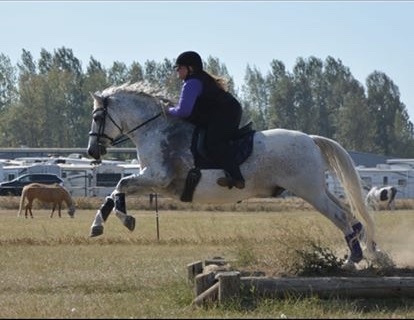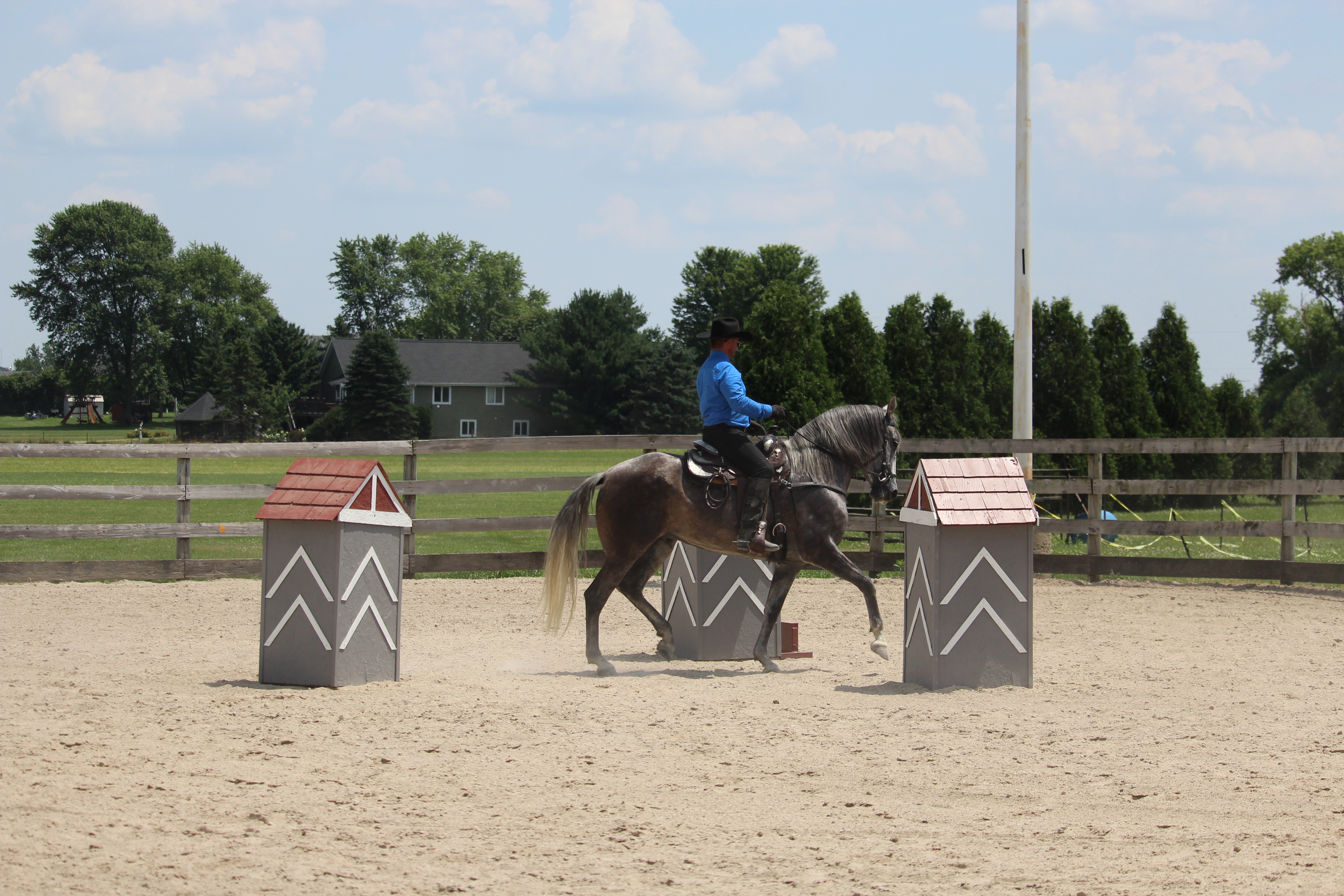Ease of Handling Trial
Ease of Handling Trial
Ease of Handling (EOH) is the second trial of a Working Equitation competition. The EOH trial is required at all performance levels–Introductory, Novice, Intermediate, Advanced, and Masters.
-
- Read about the Ease of Handling Course.
- Understand the EOH Scoring Scale.
- Find out about the Required Gaits for each competition level.
- See the Special Allowances for Introductory and Novice Levels.
- Avoid EOH Disqualifications.
- Check out the Working Equitation Obstacles.
Ease of Handling Course
The judge or the technical delegate is responsible for approving the design of the Ease of Handling course, but they do not need to design the course.
Courses can be designed by any member of the show staff, but only if they are not riding in the competition.
Courses may include any of the obstacles that are allowed for the given performance level.
The minimum number of obstacles required for the EOH course are:
-
- 10 obstacles at Introductory and Novice levels
- 13 obstacles at Intermediate levels
- 15 obstacles at Advanced Masters level
A course map must be provided to competitors at least two hours before the start of the EOH trial.
Competitors are allowed to walk the course (on foot with no horses) during the designated course walk for their class. This allows riders to memorize and plan their course before riding.
EOH Scoring Scale
As with the Dressage trial, each of the EOH obstacles is scored using the following scoring rubric:
- 10 – Excellent
- 9 – Very Good
- 8 – Good
- 7 – Fairly Good
- 6 – Satisfactory
- 5 – Sufficient
- 4 – Insufficient
- 3 – Poor
- 2 – Bad
- 1 – Very Bad
- 0 – Not Executed
In addition, the judge provides Collective Marks at the conclusion of the test for:
-
-
- transitions/navigation
- gaits
- impulsion
- submission
- rider
- presentation
-
Half points are allowed in EOH trials in the United States.
Required Gaits
Introductory
Must perform all obstacles at either walk or trot, and must trot between obstacles (see Table 6-1 in the Rules).
Novice A
Canter is required between obstacles, and changes of lead are through the trot. Obstacles must be trotted unless required or allowed to be walked (see Table 6-1 in the Rules).
Novice B
Canter is required between obstacles, and changes of lead through the trot are required. Obstacles must be cantered unless required or allowed to be walked or trotted.
Intermediate A
Canter is required in and between obstacles, and changes of lead through the walk are required. Obstacles must be cantered unless required or allowed to be walked.
Intermediate B
Canter is required in and between obstacles, and flying changes of lead are required. Obstacles must be cantered unless required or allowed to be walked.
Advanced and Masters
Canter is required in and between obstacles, and flying changes of lead are required. Obstacles must be cantered unless required or allowed to be walked, and one hand must be used on the reins exclusively.
Special Allowances for Introductory and Novice Levels
During Ease of Handling, competitors in Introductory and Novice levels are allowed three refusals (each penalized in scoring).
If the third try is unsuccessful, the rider can, with the authorization of the Judge, move on to the next obstacle, and a score of 0 is given for the obstacle not completed.
EOH Disqualifications
Errors of course and other errors can result in disqualification from the Speed trial. Some reasons that competitors might be disqualified from the Speed trial include:
- Going off course or crossing through an obstacle out of order.
- Passing through the course entry/exit marker(s) except when starting/finishing the ride.
- Three refusals at an individual obstacle.
- Failure to advance for 15 seconds.
- Uncorrected mistake in execution/route of an obstacle.
- Failure to enter/exit an obstacle through the markers.
- Failure to retrieve a dropped item and finish the requirements of the obstacle (except as noted in the Gate obstacle).
- Failure to ride through water in the Water obstacle without at least one of the horse’s hooves touching the water.
- Stroking the horse or touching it on the neck in front of the rein hand three times.
- Knocking down an obstacle that has not yet been completed.
- Switching the hand used to perform the obstacles (for example: opening the gate with the right hand but picking up the pole with the left hand).
- Unnecessary roughness (severe use of reins/spurs) – the Judge has the right to disqualify a competitor for excessive roughness.
Working Equitation Obstacles
Bridge
Download instructions for building a WE bridge, courtesy of members Howard and Erica Peet.
The bridge is an obstacle that horses and riders may be required to navigate during the Ease of Handling and/or Speed trials. This obstacle can be used at all levels.
CONSTRUCTION
The bridge should be made of wood and be soundly built in order to safely accommodate the weight of a horse and rider.
According to the Working Equitation Rules, the bridge must be at least 1.5 meters (5 feet) wide, and at least 4 meters (13 feet) long. The minimum height at the center of the bridge is 20 centimeters (8 inches). If side rails are used, they should be between 91 cm – 1.2 meters (3-4 feet) in height.
Execution – The bridge must be crossed at a walk in the Ease of Handling phase for all levels. The bridge may be crossed in both directions provided that there is one obstacle in between the first and second crossing.
Horses and riders should approach the bridge straight, without hesitation. They should transition to a walk before ascending the bridge. When scoring this obstacle, the judge will consider the quality of the transitions, the quality of the walk over the bridge, and the overall harmony and confidence exhibited by the horse and rider.
Figure 8

At the Introductory level, this obstacle may be completed at the walk or trot. At the Novice A level, this obstacle must be performed at the trot. At the Novice B, Intermediate A/B, Advanced, and Masters levels, this obstacle must be performed at the canter.
CONSTRUCTION
Two drums or upright barrels, placed 3 meters (10 feet) apart as measured from the center of each drum. The obstacle number should be placed on or near the first drum.
Execution – The horse performs a circle around the righthand drum. Upon completing the turn, halfway between the drums, the horse will change direction and begin a circle of the same diameter around the left-hand drum. When completing the second circle, the horse must pass between the drums to exit the obstacle. The circles must be uniform in size with the change of lead and/or bend on-center between the drums. A circle size of 3 m (10 ft) represents the highest degree of execution. The Advanced (L6) and Masters (L7) levels may be required to rein back through the obstacle after the initial circuits in the forward direction. The first circuit in reverse must circle the drum on the right. If this option is included, it must be indicated on the course map.
Pen
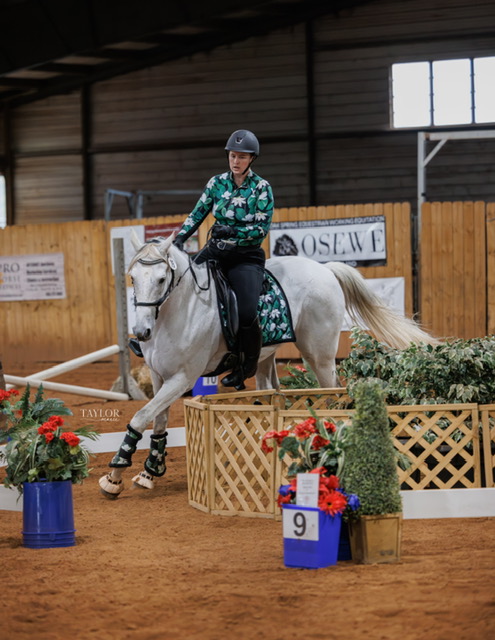
When changing direction, the horse will execute a semicircle, half pirouette, or turn on the haunches. If cantering, a change of lead is required.
EASE OF HANDLING
If the pen is included on the Ease of Handling course at the Introductory or Novice level, competitors must walk for this obstacle. At the Intermediate, Advanced, and Masters levels, competitors may walk or canter this obstacle.
Competitors will be disqualified at this obstacle for errors of course, including but not necessarily limited to the following instances:
- They navigate the pen in the wrong direction when the course map indicates a prescribed direction
- They fail to navigate the pen traveling both directions
- They exit the pen before completing the obstacle
and do no redo the obstacle
CONSTRUCTION
The pen for Working Equitation consists of an inner pen in the shape of a circle surrounded by an outer barrier also in the shape of a circle, with an opening for entry/exit. The inner pen should contain small animals or replicas of small animals.
The inner pen should be approximately 3 meters (10 feet) in diameter. The outer pen should be approximately 6 meters (20 feet) in diameter. The opening for entry/exit should be 1.5 meters (5 feet) wide.
Jug
This obstacle consists of an empty jug with a handle placed on top of a table, about 1.2 meters (4 ft) high. The table may be another common material such as a drum, barrel, or stack of hay bales provided the surface is flat.
Assessment Criteria (EOH) – The Judge will evaluate the manner in which the horse approaches and remains immobile next to the table without showing any fear and trusting the rider’s use of aids. The jug, when placed on the table, must remain upright. Any jarring movement against the table will result in a lower score. Intermediate A through Masters level riders will receive a higher score for approaching the table at canter with a good canter-to-halt transition.
The horse must depart at the same gait as it approached the obstacle. If there are entrance and exit flags for the obstacle, these flags are considered transition points.
If the jug is dropped, a member of the ground crew will hand the jug to riders competing at Introductory level. Novice-level riders must dismount, retrieve the jug, remount and replace the jug on the table. Failure to dismount, retrieve the jug and remount will result in a 0 for the obstacle (provided the rider has received permission from the judge to leave the obstacle and receive a 0 score) or disqualification (in the case of a rider leaving the obstacle unfinished without first receiving permission from the judge to proceed). Intermediate A through Masters riders must dismount, retrieve the jug, remount, and replace the jug; failure to do so will result in disqualification.
Remove Pole
CONSTRUCTION
An open-topped drum or barrel with a 2.5 – 3.5 meter (8-11.5 foot) long pole set upright inside. The tip of the pole should be clearly marked with a taper or with distinct color.
Execution – To complete the obstacle, the horse and rider approach the open-topped drum in the working gait required for their level. While passing by the drum, the rider removes the pole from the drum without an interruption of forward movement. The rider may circle the drum once before picking up the pole, though this is considered less difficult than a straight approach.
If the rider drops the pole during the course of this obstacle:
- At the Introductory level, a member of the grounds crew may retrieve the dropped pole and hand it (butt end down) to the rider.
- At the Novice levels, a rider may dismount and retrieve the pole or continue on the course without retrieving the pole, but receive zero points for the obstacle (provided they have received permission from the judge to proceed). Riders who leave the obstacle unfinished without first receiving permission from the judge to proceed are disqualified.
- At all other levels, the rider must dismount, retrieve the pole, remount with the pole in hand, and continue on the course. Failure to do so will result in disqualification.
Spear Ring
Often, the ring is affixed atop the cutout of a bull as a test of the horse’s confidence and to honor the tradition of working cattle on horseback.
CONSTRUCTION
The obstacle consists of a pole and a ring. The pole is taken from the Remove Pole obstacle. If using multiple rings, the rings should be set at varying heights. It is traditional, but not required, for the base to be in the shape of a bull with the ring placed on top. The rings can be made out of wood, metal, or plastic and should be approximately 15 cm (6 in.) in diameter.
Execution – The competitor must skewer the ring(s) with the tip of the pole. The horse must maintain gait as prescribed for their performance level.
If the pole is dropped, a member of the ground crew will hand the pole to riders competing at the Introductory level. Novice-level riders must dismount, retrieve the pole, and remount with the pole in hand or receive a 0 for the obstacle (provided they have received permission from the judge to proceed). Riders who leave the obstacle unfinished without first receiving permission from the judge to proceed are disqualified. Intermediate through Masters riders must dismount, retrieve the pole, and remount with the pole in hand. Failure to do so will result in disqualification.
Replace Pole
Riders are advised to avoid throwing the pole into the drum, as doing so often results in the pole bouncing out.
Execution – The pole is deposited with the butt end down in the drum. The rider may circle the drum once before replacing the pole, though this is considered less difficult than a straight approach. The horse must maintain gait as prescribed for their performance level.
The pole must be deposited into and remain in the drum. If the pole bounces out or is dropped, a member of the ground crew will hand the pole to riders competing at the Introductory level. Novice (L2/L3) level riders must dismount, retrieve the pole, and remount with the pole in hand or receive a 0 for the obstacle (provided they have received permission from the judge to proceed). Riders who leave the obstacle unfinished without first receiving permission from the judge to proceed are disqualified. Intermediate (L4) through Masters (L7) riders must dismount, retrieve the pole, and remount with the pole in hand. Failure to do so will result in disqualification.
Switch Cup
This obstacle consists of two poles that are approximately 2 meters (6.5 feet) in height, with an exterior base not secured in the ground. The poles are set 1.2-meters (4-feet) apart. A drinking cup is placed upside down on the tip of one of the poles. The cup must be placed on the same pole for all competitors in the division or level.
Execution – Horses and riders must enter between two upright poles at the prescribed gait and halt between the two poles. Then, the rider lifts a cup from the top of one pole and moves it to the top of the other pole. Once the cup has been positioned, the horse and rider ride forward to exit the obstacle at the prescribed gait.
If the cup is dropped, a member of the ground crew will hand the cup to riders competing at the Introductory level. Novice level riders must dismount, retrieve the cup, and remount with the cup in hand or request permission from the judge to receive a 0 for the obstacle before moving on. Leaving the obstacle without receiving permission from the judge to do so results in disqualification. Intermediate through Masters riders must dismount, retrieve the cup, and remount with the cup in hand. Failure to do so will result in disqualification.
All four hooves of the horse exiting the bell-end of the corridor results in disqualification from the trial.
Execution – The horse and rider enter the corridor at the prescribed gait for the level and halt at the end of the corridor. Depending on the configuration, the rider either: (1) Rings the bell and backs down the “L” corridor to exit the obstacle, or (2) Removes the cup and backs down the “L” corridor. Upon exiting, the rider halts and places the cup on the pole at the entrance corresponding with the side from which the cup was removed.
If the cup is dropped, the rider must dismount, retrieve, remount, and place the cup. If the pole that the cup is to be placed on is knocked down, riders must dismount, reset the pole, remount, and place the cup on the pole. Failure to replace the cup on the designated pole while mounted will result in disqualification.
Bell Corridor
CONSTRUCTION
To build this obstacle, set up a straight corridor about 3.7 meters (12 feet) long consisting of parallel poles resting on supports, small fences, or walls at least 30 cm (12 inches) in height. The corridor should be spaced 1.5 meters (5 feet) wide and be open at either end. A bell should be centered at the end of the corridor suspended at a height of about 2 meters (6.5 feet).
Beyond Introductory level, the Corridor can also be set in an “L” shape. The photo to the left shows the straight corridor on the right of the photo and the “L” corridor where the horse is standing.
All four hooves of the horse exiting the bell-end of the corridor results in disqualification from the trial.
Reinback “L”
Reinback ‘L’ is not used at the Introductory level.
CONSTRUCTION
This obstacle consists of an “L”-shaped corridor with either a bell at the far end or poles with cups set at the far end and two poles (where the rider will place the cup upon exiting the corridor) set at the entry.
Competitors may enter the obstacle at the following gaits:
- Novice: Walk or trot
- Intermediate and Advanced: Walk or canter
- Masters level: Canter
If entrance and exit flags are used with this obstacle, the horse and rider must pass between the flags with the red flag on their right and the white flag on their left. When exiting the obstacle, the horse and rider must back between the flags in order to complete the obstacle.
Execution – The horse and rider enter the corridor at the prescribed gait for the level and halt at the end of the corridor. Depending on the configuration, the rider either: (1) Rings the bell and backs down the “L” corridor to exit the obstacle, or (2) Removes the cup and backs down the “L” corridor. Upon exiting, the rider halts and places the cup on the pole at the entrance corresponding with the side from which the cup was removed.
If the cup is dropped, the rider must dismount, retrieve, remount, and place the cup. If the pole that the cup is to be placed on is knocked down, riders must dismount, reset the pole, remount, and place the cup on the pole. Failure to replace the cup on the designated pole while mounted will result in disqualification.
Rounding Posts
CONSTRUCTION
Two lines of three posts each. The distance between the three posts should be 2.5 – 3 meters apart (8-10 feet). The width between the parallel lines should be spaced exactly 1.5 meters (5 feet) apart. A cup is placed upside down on the top of each of the two posts at the destination end of the lines (this allows for left- or right-handed riders to navigate the obstacle).
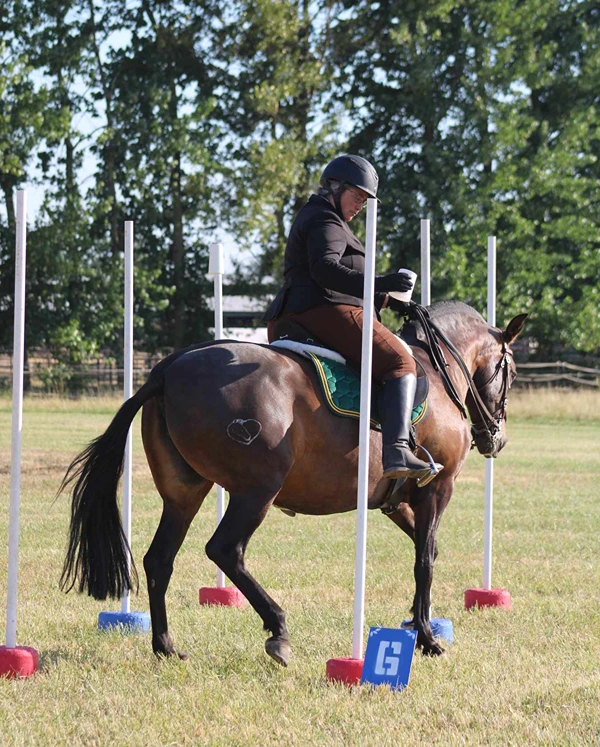
Photo courtesy of Diane Yin Chang’e
Execution – At the Introductory and Novice levels, horses walk or trot to enter the obstacle and back straight between the posts to exit the obstacle. At the Intermediate level horses and riders must walk or canter into the obstacle, halt at the end, and weave back around the middle post on the same side from which they removed the cup during the backing portion of the obstacle. For example, if the rider selected the right-hand cup, then they must weave backward around the middle post on the righthand line of posts for the backing portion. At the Advanced and Masters level, horses enter the obstacle at a canter before reining back in a slalom pattern as described for Intermediate.
In all cases, riders enter the corridor, halt, and remove a cup from the tip of one of the poles at the end of the corridor, keep the cup in the same hand throughout the execution of the obstacle, rein back in the designated pattern (depending on level, see above), then halt and deposit the cup on the tip of the post at the entrance of the corridor corresponding with the side from which the cup was retrieved.
DISQUALIFICATION
In addition to going off course, there are a number of ways in which a rider may be disqualified for incorrectly performing this obstacle, including:
- The rider uses an inconsistent hand to retrieve the cup.
- The horse or rider knocks over the final post on which to place the cup or drops the cup without properly correcting the course error.
- The rider fails to place the cup on the designated post (corresponding with the side of the corridor from which they picked up the cup).
WHAT TO DO IF PART OF THE OBSTACLE FALLS
If the horse or rider knocks over the post on which they must place the cup, the rider must dismount, return the post to an upright position, remount, then place the cup on top of the pole while mounted. Failure to do so results in disqualification.
If the rider drops the cup, they must dismount, retrieve the cup with the same hand they used to retrieve it originally, remount, and complete the obstacle. Failure to do so results in disqualification. It is acceptable to use a mounting block if a mounting block is available within the arena.
If a horse or rider knocks over a “non-essential” portion of the obstacle, such as the obstacle number or a middle post, they will receive a negative score in the EOH trial and a 5 second penalty for each portion of the obstacle knocked over in the Speed trial. The rider does not need to dismount and remount to fix a non-essential fallen portion of the obstacle.
Double Slalom
An odd number of vertical posts or something similar to posts placed in two staggered parallel lines, each post 2 meters (6.5 feet) in height spaced 6 meters (20 feet) apart. The posts should not be fixed to the ground; in the event a horse bumps into a post the post should be able to fall over.
At the Introductory, Novice, and Intermediate levels, a minimum of five posts must be used. For Advanced and Masters levels, a minimum of seven posts must be used.
Entry flags should be used to indicate the correct side in which to enter the obstacle, and exit flags should indicate the correct exit point.
Single Slalom
An odd number of vertical posts, approximately 2 meters (6.5 feet) in height are placed 6 meters (20 feet) apart in a straight line. A minimum of five posts is required for this obstacle at all levels. A marker indicating the correct side of entry or the obstacle number is placed alongside the first post. The posts should be placed on base, not fixed to the ground, so that the post will fall over if struck by the horse.
Execution – The obstacle is entered in the prescribed gait. If there are no flags marking the exit of the obstacle, the obstacle is complete when the horse has broken the plane between the two final posts. The line of travel should be weaving through the posts rather than loops around the posts. Lead changes must be performed as prescribed for that level. Changes of bend and lead are to be executed at each change of direction, in the line and midway between the posts. The horse’s lead and bend should be in conformity with the turn.
The horse and rider navigate the slalom at the gait required for their performance level:
- Introductory, Novice A and Novice B must trot
- Intermediate, Advanced, and Masters must canter
The horse should demonstrate a change of bend, and if cantering, a change of lead, at the center point between the posts.
A judge will give a negative score (4 or less) if the horse and rider fail to perform changes of lead, performs the lead changes poorly, performs the obstacle in counter canter, or knocks over any of the posts. A rider does not have to dismount to reset a fallen post, but should still be sure to complete the weaving pattern.
Gate
The gate must be at least 1.3 meters (4 feet 3 inches) high and 2 meters (6.5 feet) wide, supported by two weighted posts (or jump standards) and two hinges. A latch easily operated from horseback should be used. The gate can be opened to the right or left depending on how the obstacle is set in the course. A rope between two posts can be used instead of a solid gate.
A solid gate is preferred for Ease of Handling and is required in ‘A’ rated and championship competitions; a rope gate should be used for Speed.
Execution – The rider approaches perpendicular to the gate at the prescribed gait for the level and transitions to the walk as he/she approaches the gate. The rider then moves the horse laterally and halts alongside the gate. The rider must lift the latch, open the gate, and go through the entrance. When the horse has fully passed to the other side of the gate, the rider may back up to close the gate. With the horse squarely halted, the rider will then put the latch in place to complete the obstacle. The rider should not release control of the gate at any point in the performance of this exercise until the gate is latched. The obstacle may be required in both directions providing there is at least one obstacle in between the first and second execution.
Jump
CONSTRUCTION
The obstacle consists of a single jump in a progression of heights for each level. Standard jump rails or a solid wood obstacle (like a flower box) can be used. Bales of straw placed end-to-end are acceptable. The jump must be at least 3-m (10-ft) across and must be positioned between two jump standards with appropriate jump cups.
Introductory: Jump consists of a pair of crossed rails not to exceed 0.3 m (12 in.) at the center. Novice A & B: Jump consists of a pair of crossed rails not to exceed 0.5 m (22 in.) at the standard and 0.4 m (15 in.) at the center. Intermediate A – Masters: Jump consists of a solid-looking obstacle or rails set 0.5-m (22-in.) high with a ground pole placed under the jump. The jump may be set up to 1-m (39-in.) high for Masters Level riders.
Execution – The horse should approach and jump over the obstacle cleanly, naturally, and with assurance at prescribed gait for their performance level. The obstacle may be required in both directions providing there is at least one obstacle in between the first and second execution.
Sidepass Rail
Sidepass Rail is not used at the Introductory level.
CONSTRUCTION
The poles should be about 3.7 meters (12 feet) in length with a diameter of about 10 cm (4 inches), supported 5?10 cm (2?4 inches) above the ground.
Depending on the performance level, this obstacle may be comprised of a single log or multiple poles in the following formations:
- Two poles in a line separated by at least 3 meters (10 feet) – Novice, Intermediate, Advanced, or Masters levels
- Two parallel poles separated by 3 meters (10 feet) – Novice, Intermediate, Advanced, or Masters levels
- Two poles in an “L” shape – Intermediate, Advanced, or Masters levels
- Three poles set at 90 degrees in a “Z” shape – Masters level
If the poles are knocked by a horse during a competition, a member of the ground crew should reset the poles as needed before the next competitor attempts the obstacle.
Water
CONSTRUCTION
The water-filled ditch should be at least 1.5 meters (5 feet) wide and 2.4 meters (8 feet) long and no deeper than 0.6 meters (2 feet). There must be a visible barrier demarcating the edges of the ditch and the surface at the bottom of the ditch should be safe for horses. Course markers must be used to mark the entrance and exit. The obstacle may be framed with logs so horses have to step over and into/out of the water.
Execution – The horse should approach and walk calmly through the water naturally and without any hesitation. The judge will give a negative score if the horse and rider jump the ditch or if they refuse the ditch by stopping and stepping backwards.
Bank
CONSTRUCTION
The bank consists of an embankment of natural substance positioned not more than 30-60 cm (1-2 feet) above ground level. A level plateau is at the top and bottom of the embankment; the plateau must be at least 2 meters (6.5 feet) long in the direction of travel. There may be ramps leading to and away from the level plateaus.
Execution -The horse should approach and maintain the chosen gait through the obstacle naturally and without any hesitation. The obstacle can be executed as either an up-bank or a down-bank. Both an up-bank and a down-bank may be incorporated and scored as one obstacle.
At the Novice level horses and riders may trot, or canter the bank. At the Intermediate level or above, horses and riders must canter over the bank.
Drums
This obstacle consists of three drums or similar objects such as barrels or posts arranged in the shape of an equilateral triangle. The obstacle number should be placed on or near the first drum. For the purpose of describing the pattern, we will designate the drum on the bottom right as “A”, the one at the top of the triangle as “B”, and the one on the bottom left as “C”.
At the Introductory, Novice, and Intermediate levels the center to center spacing between drums is 4 meters (13 feet). For Advanced and Masters levels, the center to center spacing between drums is 3 meters (10 feet).
Execution – The horse enters at the appropriate gait for the level between drums A & C. This obstacle can then be executed in either direction, depending on the course map or as designated by the Judge:
(1) The horse makes a full circle to the right around drum A. The horse proceeds to pass halfway between drums A & B, with a change of lead and/or bend over the imaginary line between A & B. The horse makes a loop to the left around drum B. The horse then proceeds to pass halfway between drums B & C, with a change of lead and/or bend along the imaginary line between B & C. The horse makes a full circle to the right around drum C, and exits at the same point from which the exercise began.
0r
(2) The horse makes a full circle to the left around drum C. The horse proceeds to pass halfway between drums C & B, with a change of lead and/or bend over the imaginary line between C & B. The horse makes a loop to the right around drum B. The horse then proceeds to pass halfway between drums B & A, with a change of lead and/or bend along the imaginary line between B & A. The horse makes a full circle to the left around drum A, and exits at the same point from which the exercise began.
For the best score, horses and riders should ride the same size circles around the drums to create symmetry.
